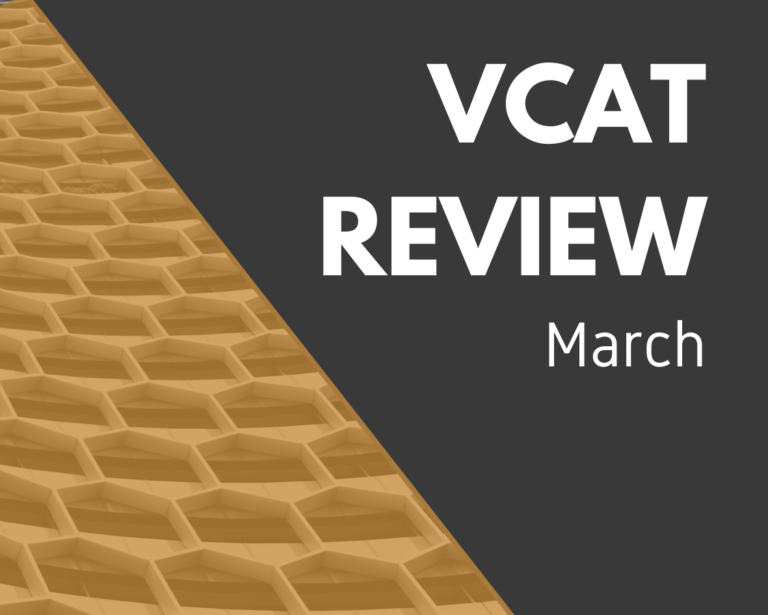Bottomley v Boroondara CC [2024] VCAT 200 involved the use of land for a dental laboratory in a Commercial 1 Zone. As an initial matter, the Tribunal had to grapple with the characterisation of the use. The Tribunal determined that it was ‘industry’ as opposed to an innominate use given it involved a process of manufacturing. Under the C1Z, industry is a Section 2 land use with a condition that it ‘must not be a purpose listed in the table to Clause 53.10’. Having formed the opinion the use proposed was ‘industry’, the Tribunal subsequently had to grapple with whether it was for a purpose listed in the table to Clause 53.10 namely ‘printing and coating works with heated curing ovens’. The Tribunal found:
30. Council’s position, reinforced by its legal opinion, was that the dental laboratory in making dentures fits within the concept of ‘any process of manufacture’. The respondent agrees and the applicant does not dispute that the dental laboratory use is not an industry.
31. Council’s view is that the dental laboratory involves the making of dental products. The making of many, if not all, of the dental products involves the mechanical and physical process of material gathering, assembly of parts and formation.
32. There was discussion about the scale of an industry, however, I accept that the scale of manufacturing associated with the dental laboratory is small and not of a scale that involves the use of a large factory building. I accept that manufacturing is occurring and that the making of dentures is a form of manufacturing, however, it is an activity that is clearly of a small scale with work on dental products that are small, and which utilises machinery that can comfortably be accommodated on desks similar to an office desk or benchtop.
33. Reference to industry invokes a broad range of activities and I am comfortable in including reference to dental laboratory in the permit preamble to ensure there is reference to the specific activities on the site and not the broader range of uses included in the definition of industry.
34. Under the C1Z, industry is a permit required use that carries a condition that it ‘must not be a purpose listed in the table to Clause 53.10’. Clause 53.10 is one of the general requirements and performance standards provisions of the planning scheme. It relates to identifying those types of uses and activities, which if not appropriately designed and located, may cause offence or unacceptable risk to the neighbourhood. It further nominates threshold distances to land in the C1Z and residential zones, amongst others, and to land used for an education centre, amongst others, where an application listed in the table must be referred to the Environment Protection Authority (‘EPA’) if the threshold distance is not met.
35. As mentioned earlier, under ‘Miscellaneous manufacturing’ there is reference in the table to Clause 53.10 to ‘Printing and coating works with heated curing ovens’ and including a threshold distance of 500 metres. Council’s submission opines that ‘Planning Practice Note 92 – Managing buffers for land use compatibility, March 2021’ includes a description in Appendix A of the various activities listed in the table. For ‘Printing and coating works with heated curing ovens’ it refers to the following description of activity:
Printing works emitting volatile organic compounds; printing and/or providing reprographic services. Printing methods may include off-set lithographic, reprographic, digital, relief and screen printing.
36. I accept the above is a guide, but from the combination of submissions, material presented and my inspection, it is reasonable to accept that the nature of the use is not of a sufficiently large or industrial scale to fit under this term.
37. My views on this are supported by referring to the ‘Recommended separation distances for industrial residual air emissions (Publication 1518, Environment Protection Authority, March 2013)’ which is listed as a policy document under Clause 13.06-1S which includes in Table 1 reference to ‘Manufacture of products using fiberglass and resin’ and the scale of such industry at greater than 250 tonnes per year. Similarly for printing works, the reference is to such works emitting volatile organic compounds greater than 100 kilograms per day. These are substantial and truly industrial scale activities. The dental laboratory does not achieve these quantities of production or emissions.
38. I have taken a purposive approach to this issue and note that there is printing but on a relatively small scale and associated with 3D printing of denture moulds. This activity does not emit volatile organic compounds of large quantities. There is coating but on the basis of small-scale glazing and polishing and there is use of a curing furnace, but of a small domestic scale used for small items being denture moulds.
39. I am not convinced that the dental laboratory is of the large scale of manufacturing that is envisaged under Clause 53.10. A separation distance of 500 metres suggests that more substantial activities are intended to be captured under the clause. Small machinery and working by hand (akin to craftwork) occurs on the site. This is not of the scale or effects envisaged to be covered under Clause 53.10.
40. Hence, I am comfortable that the use on the site for a dental laboratory is a form of small-scale industry that does not fit within the purposes listed under Clause 53.10.
Trabant v Maribyrnong CC [2024] VCAT 208 was principally concerned with whether the extent of overshadowing of a neighbouring property was acceptable. The application was assessed under Clause 55 but it was found that it should have been assessed under Clause 54. While noting no difference in the overshadowing standard and decision guidelines between A14 and B21, the Tribunal noted, without making comment upon, the difference in the wording of the respective objectives being:
6. The objective of clause 55.04-5 is as follows (my emphasis):
To ensure buildings do not significantly overshadow existing secluded private open space.
7. The objective of clause 54.04-5 is as follows (my emphasis):
To ensure buildings do not unreasonably overshadow existing secluded private open space of dwellings or small second dwellings.
Standard A14 was not met, with a 1sqm, 2sqm and 5sqm increase in shadow cast at 1pm, 2pm and 3pm respectively. In addition to expressing concern with this additional extent of overshadowing cast, the Tribunal reinforced the importance of the Tika v Yarra CC (Red Dot) [2018] VCAT 894 and Ling v Whitehorse CC (Red Dot) [2023] VCAT 307 decisions stating:
18. The Council’s submission is that the starting point for assessment is whether the SPOS receives solar access to at least 75% of its area, being 30sqm for five hours. The Council’s analysis shows that is not achieved at any hour between 9:00am-3:00pm. At best, the applicant’s courtyard receives 24.5sqm of sunlight at midday, followed by 21sqm (to be reduced to 20sqm) at 1:00pm. As the afternoon progresses, the extent of shadow increases. The Council’s calculations show the courtyard currently receives 8.7sqm of sunlight at 3:00pm and will be reduced by 5sqm, to 3.7sqm at this time as a consequence of the proposed carport.
…
23. I am not satisfied the application material depicts the full extent and duration of existing shadows cast over the SPOS of the applicant’s property, as the plans fail to depict:
– The shadow cast by the applicant’s existing northern boundary fence.
– The shadow cast by the applicant’s dwelling at all relevant times.
– The quantum of sunlight enjoyed by the applicant’s property at all relevant times.
Nasralla v Hobsons Bay CC [2024] VCAT 212 concerned the proposed construction of two dwellings within proximity to the Qenos Major Hazard Facility. The Tribunal relevantly remarked initially:
47. As is apparent from the grounds of refusal, but for the safety and compatibility issues raised in the grounds of refusal, in terms of the NRZ6 the Council has no concerns with the acceptability of the Land being developed with two dwellings in a strategic policy sense, the design of the proposal in a neighbourhood character sense, or its potential to lead to any on‑site or off‑site amenity impacts.
This is not the first such application in Hobsons Bay that has come before the Tribunal on the basis of risk, with the Council outlining a number of recent decisions of the Tribunal involving residential developments in proximity to major hazard facilities in Hobsons Bay. However, what sets this decision apart is that with reference to several other VCAT decisions including Brunswick Investment Project Pty Ltd v Moreland CC [2021] VCAT 1191 and Booth v Strathbogie SC [2023] VCAT 782 the Tribunal found:
238. I find that the potential human health, property and safety impacts and risks the subject of clauses 13.07-1S and 13.07-2S of the Scheme are not relevant to the development permission sought under clause 32.09-7 of the Scheme of the NRZ6.
As per the paragraph numbering this is an extensive decision outlining the Tribunal’s consideration of whether this policy and that at Clause 17.03-2S was relevant to the exercise of discretion. It is one of several in recent times which go to this question of the exercise of discretion and ‘upend’ established thinking as to relevant considerations. In this matter the Council suggested that the Department was preparing a BAO for major hazard facilities, and in light of this decision it will be interesting to see how the Council, WorkSafe (who objected to the application) and the Department react.
For completeness it must be noted that the Tribunal stated that even were it wrong in respect of the risk question and the applicability of these policies, it would have approved the application in any case based on the specific facts and circumstances of the application.
O’Neill v Hepburn SC [2024] VCAT 197 received some media attention being a proposal for a small-scale abattoir to service local farm needs on the basis that smaller farms such as the permit applicants were having increased difficulty in accessing appropriate abattoirs. The Tribunal confirmed Council’s decision, commenting:
31. In light of the lack of any clear planning policy discouraging an abattoir in the Farming Zone; the ability for a permit to be granted for an abattoir; the small scale nature of this proposed abattoir (rural industry); and, for reasons that I will explain next, the lack of any material to indicate that this small scale rural industry will produce unacceptable amenity impacts, I am persuaded that it is appropriate to grant a permit for the proposed abattoir in the Beacon Paddock part of this site.
Duvoux Pty Ltd v Hobsons Bay CC [2024] VCAT 143 concerned a property in Newport containing two heritage dwellings. For a short period at least, it appeared to that one of the dwellings may be of State and potentially international significance were it confirmed to be a pre-fabricated house shipped from America (spoiler, ultimately it was not). For those practitioners interested in heritage planning this is a decision which would be of interest as it grappled with considerations of what fabric was and was not significant and the extent of the significance, partial demolition, questions of ‘demolition by neglect’, relocation of built form, as well as more ‘ordinary’ matters of buildings and works and subdivision.
Glossop Town Planning enjoyed another busy month appearing before the Tribunal either as an advocate (Hew Gerrard) or expert planning witness (John Glossop). If Glossop Town Planning could potentially be of assistance with any VCAT related matters, please contact our office on 9329 2288 or via email at mail@glossopco.com.au.


